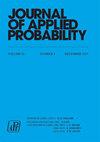广义两群体随机块体模型的相变
IF 0.7
4区 数学
Q3 STATISTICS & PROBABILITY
引用次数: 0
摘要
我们研究了从具有两个群落的广义随机块模型(G2-SBM)中检测群落结构的问题。基于对经验谱分布的Stieljtes变换的分析,我们证明了G2-SBM最大特征值的Baik–Ben Arous–Péché(BBP)型跃迁。对于特定的模型,如隐藏社区模型和不平衡随机块模型,我们提供了两个最大特征值的精确公式,建立了BBP型转换中的间隙。本文章由计算机程序翻译,如有差异,请以英文原文为准。
Phase transition for the generalized two-community stochastic block model
We study the problem of detecting the community structure from the generalized stochastic block model with two communities (G2-SBM). Based on analysis of the Stieljtes transform of the empirical spectral distribution, we prove a Baik–Ben Arous–Péché (BBP)-type transition for the largest eigenvalue of the G2-SBM. For specific models, such as a hidden community model and an unbalanced stochastic block model, we provide precise formulas for the two largest eigenvalues, establishing the gap in the BBP-type transition.
求助全文
通过发布文献求助,成功后即可免费获取论文全文。
去求助
来源期刊

Journal of Applied Probability
数学-统计学与概率论
CiteScore
1.50
自引率
10.00%
发文量
92
审稿时长
6-12 weeks
期刊介绍:
Journal of Applied Probability is the oldest journal devoted to the publication of research in the field of applied probability. It is an international journal published by the Applied Probability Trust, and it serves as a companion publication to the Advances in Applied Probability. Its wide audience includes leading researchers across the entire spectrum of applied probability, including biosciences applications, operations research, telecommunications, computer science, engineering, epidemiology, financial mathematics, the physical and social sciences, and any field where stochastic modeling is used.
A submission to Applied Probability represents a submission that may, at the Editor-in-Chief’s discretion, appear in either the Journal of Applied Probability or the Advances in Applied Probability. Typically, shorter papers appear in the Journal, with longer contributions appearing in the Advances.
 求助内容:
求助内容: 应助结果提醒方式:
应助结果提醒方式:


